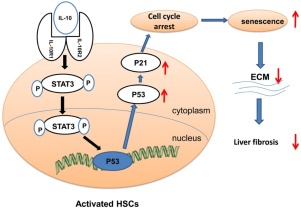当前位置:
X-MOL 学术
›
Cell. Signal.
›
论文详情
Our official English website, www.x-mol.net, welcomes your
feedback! (Note: you will need to create a separate account there.)
Interleukin-10 induces senescence of activated hepatic stellate cells via STAT3-p53 pathway to attenuate liver fibrosis.
Cellular Signalling ( IF 4.4 ) Pub Date : 2019-11-12 , DOI: 10.1016/j.cellsig.2019.109445 Yue-Hong Huang 1 , Ming-Hua Chen 1 , Qi-Lan Guo 1 , Zhi-Xin Chen 1 , Qing-Duo Chen 1 , Xiao-Zhong Wang 1
Cellular Signalling ( IF 4.4 ) Pub Date : 2019-11-12 , DOI: 10.1016/j.cellsig.2019.109445 Yue-Hong Huang 1 , Ming-Hua Chen 1 , Qi-Lan Guo 1 , Zhi-Xin Chen 1 , Qing-Duo Chen 1 , Xiao-Zhong Wang 1
Affiliation

|
Hepatic fibrosis is a wound healing process which results in deposition of excessive abnormal extracellular matrix (ECM) in response to various liver injuries. Activated hepatic stellate cells (HSCs) are the major sources of ECM and induction of senescence of activated HSCs is an attractive therapeutic strategy for liver fibrosis. Our previous studies have shown that interleukin-10 (IL-10) attenuates the carbon tetrachloride (CCL4) - and porcine serum-induced liver fibrosis in rats. However, little is known about the mechanisms of IL-10 regulating the senescence of activated HSCs. The aim of this study is to uncover the underlying pathway by which IL-10 mediates activated HSCs senescence to attenuate liver fibrosis. In vivo, we found that IL-10 gene by hydrodynamics-based transfection attenuated CCL4-induced liver fibrosis associated with senescence of activated HSCs in rats. In vitro experiment confirmed that IL-10 could induce senescence of activated HSCs via inhibiting cell proliferation, inducing cell cycle arrest, increasing the SA-β-Gal activity and enhancing expression of senescence marker protein p53 and p21. Treatment with Pifithrin-α, a specific inhibitor of p53, could abrogate IL-10-increased SA-β-Gal activity and expression of P53 and P21in activated HSCs. Lastly, IL-10 also increased the expression of total and phosphorylated signal transducers and activators of transcription 3(STAT3) and promoted phosphorylated STAT3 translocation from cytoplasm to nucleus. Treatment with cryptotanshinone, a specific inhibitor of STAT3, could inhibit the phosphorylation of STAT3 and its downstream proteins p53 and p21 expression and decrease the activity of SA-β-Gal in activated HSCs induced by IL-10. Taken together, IL-10 induced senescence of activated HSCs via STAT3-p53 pathway to attenuate liver fibrosis in rats and present study will provide a new mechanism of antifibrotic effects of IL-10.
中文翻译:

白细胞介素10通过STAT3-p53途径诱导活化的肝星状细胞衰老,以减轻肝纤维化。
肝纤维化是一种伤口愈合过程,会导致多种肝损伤而导致过多的异常细胞外基质(ECM)沉积。活化的肝星状细胞(HSC)是ECM的主要来源,并且诱导活化的HSC衰老是一种有吸引力的肝纤维化治疗策略。我们以前的研究表明,白介素10(IL-10)可减轻大鼠的四氯化碳(CCL4)和猪血清诱导的肝纤维化。然而,关于IL-10调节活化的HSC的衰老的机制知之甚少。这项研究的目的是揭示IL-10介导活化的HSC衰老以减轻肝纤维化的潜在途径。体内,我们发现,基于流体动力学的转染的IL-10基因减弱了CCL4诱导的肝纤维化,与大鼠活化的HSC的衰老有关。体外实验证实,IL-10可以通过抑制细胞增殖,诱导细胞周期停滞,增加SA-β-Gal活性并增强衰老标记蛋白p53和p21的表达来诱导活化的HSC的衰老。Pifithrin-α(一种p53的特异性抑制剂)治疗可以消除IL-10升高的SA-β-Gal活性以及活化的HSC中P53和P21的表达。最后,IL-10还增加了总和磷酸化信号转导子和转录激活因子3(STAT3)的表达,并促进了磷酸化STAT3从细胞质到细胞核的转运。用STAT3的特异性抑制剂隐丹参酮治疗 IL-10可能抑制STAT3及其下游蛋白p53和p21表达的磷酸化,并降低IL-10诱导的活化HSCs中SA-β-Gal的活性。总之,IL-10通过STAT3-p53途径诱导活化的HSC衰老,以减轻大鼠肝纤维化,本研究将为IL-10的抗纤维化作用提供新的机制。
更新日期:2019-11-13
中文翻译:

白细胞介素10通过STAT3-p53途径诱导活化的肝星状细胞衰老,以减轻肝纤维化。
肝纤维化是一种伤口愈合过程,会导致多种肝损伤而导致过多的异常细胞外基质(ECM)沉积。活化的肝星状细胞(HSC)是ECM的主要来源,并且诱导活化的HSC衰老是一种有吸引力的肝纤维化治疗策略。我们以前的研究表明,白介素10(IL-10)可减轻大鼠的四氯化碳(CCL4)和猪血清诱导的肝纤维化。然而,关于IL-10调节活化的HSC的衰老的机制知之甚少。这项研究的目的是揭示IL-10介导活化的HSC衰老以减轻肝纤维化的潜在途径。体内,我们发现,基于流体动力学的转染的IL-10基因减弱了CCL4诱导的肝纤维化,与大鼠活化的HSC的衰老有关。体外实验证实,IL-10可以通过抑制细胞增殖,诱导细胞周期停滞,增加SA-β-Gal活性并增强衰老标记蛋白p53和p21的表达来诱导活化的HSC的衰老。Pifithrin-α(一种p53的特异性抑制剂)治疗可以消除IL-10升高的SA-β-Gal活性以及活化的HSC中P53和P21的表达。最后,IL-10还增加了总和磷酸化信号转导子和转录激活因子3(STAT3)的表达,并促进了磷酸化STAT3从细胞质到细胞核的转运。用STAT3的特异性抑制剂隐丹参酮治疗 IL-10可能抑制STAT3及其下游蛋白p53和p21表达的磷酸化,并降低IL-10诱导的活化HSCs中SA-β-Gal的活性。总之,IL-10通过STAT3-p53途径诱导活化的HSC衰老,以减轻大鼠肝纤维化,本研究将为IL-10的抗纤维化作用提供新的机制。











































 京公网安备 11010802027423号
京公网安备 11010802027423号